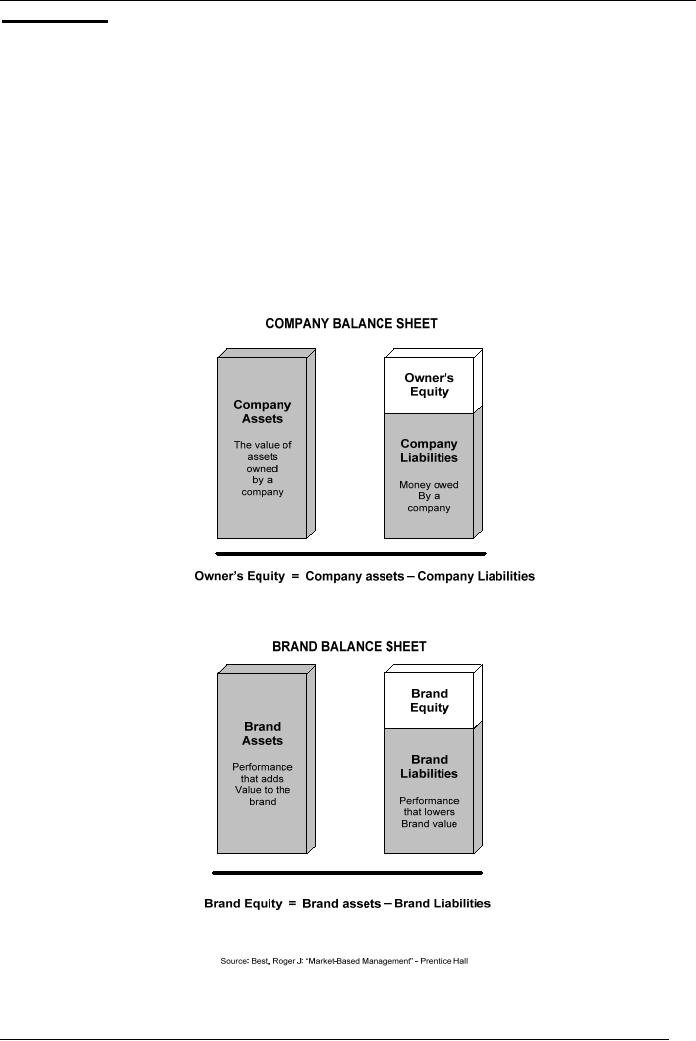 |

Brand
Management (MKT624)
VU
Lesson
2
INTRODUCTION
The
more successful a brand, the
higher value it carries and more
equity it enjoys. To
learn
what
is brand equity and how to
create it through a brand management
process is the
objective
of
this lecture?
Brand
Value and Power
Brands,
whether grown organically or
through acquisitions, have to
generate revenues,
profits,
and
net earnings to make businesses
viable. The ability to
generate financial results
rests at the
core
of brand value and power. It is
because of this value and
power that brands must
be
sustained.
Level
of value and power differ
for different brands. All brands are
intended to become great in
terms
of value and power. Some
succeed and some do
not.
To
achieve a high level of
value and power, marketing and
brand managers have been
working
to
create home in the minds of
their consumers. With the
rise in importance of brand
management,
they have become more and
more convinced that the
real value of brand is
driven
by
how dear consumers keep a
particular brand to themselves.
The endearment drives
value
and
value in turn translates
into brand power and brand
equity.
Before
understanding what brand
equity is, let's see
how varying levels of brand
value and
power
relate varying levels of
market leadership and, hence,
brand equity. This implies
that
different
levels of power offer
different levels of brand
equity. The more the
power, the higher
is
the equity and vice
versa.
The
following pieces of evidence of
strong brands were put
together by Peter Doyle
(1989)
from
the largest database of
business results in the
world Profit Impact of
Market Strategy
(PIMS).1
o
Brands
with a market share of 40%
generate 3 times as much ROI as those
with
a
share of only 10%. A higher
share means higher volumes
that offer scale
economies
and, hence, lower costs. Cost
optimization on all fronts lead to
better
margins
and returns.
o
For UK
grocery brands, the number 1
brand generates over 6 times
the return on
sales
of the number 2 brand, while
number 3 and 4 are unprofitable.
Higher
returns
on part of the number 1
brand again owe to lower costs,
optimum
outreach,
availability and better
sales.
o
For US
consumer goods, the number 1
brand earned a 20% return;
the number 2
earned
around 5% and the rest lost
money for the same
reasons as cited
above.
o
Small brands
can be profitable. A strong brand in a
niche market earns a
higher
return
than a strong brand in a big
market. An interesting finding, it
leads us to
believe
that concentration on a niche
market keeps all variables
of marketing
mix
focused, efforts economical, and
returns high no matter the
volume may
remain
small. Managing a strong
brand in a huge market,
however, demands
spread
out efforts, more resources
employed, but lower returns
no matter the
volume
may remain big. Bear in mind
that not all markets
offer the opportunity
to
operate in a niche. Therefore,
this finding is not to be
misunderstood with
not
trying
to build your brand in a
huge market.
These
findings explain why companies want to
lead by having strong brands with
very high
share
of the market. The stronger
the brands, the lower the
costs, the larger the
returns, and
more
the power the brands enjoy.
Strong brands are assets and
enjoy value that far
exceeds the
value
of those fixed assets that
produce them. Brands,
therefore, have to be managed
like vital
assets.
7

Brand
Management (MKT624)
VU
Brand
Equity
An
understanding of the concept of
brand equity helps us define
the process of brand
management.
It, therefore, must be understood
before we can put definition in
place.
In
a business, the owner's equity is
the value of owner's holding
in the company. And, that
is
defined
as the difference between
what a company owns in
assets and what it owes in
liabilities.
The larger the ratio of
assets to liabilities, the
larger is the owner's
equity.
Likewise,
brand equity is the
difference between a brand's
assets and brand's liabilities.
Brand
assets
are a function of reputation,
quality, relevance, and loyalty. The
concept is well-
illustrated
with the help of the
attached figure.
Brand
liabilities are incurred by brands
because of failures and questionable
business practices
that
may increase costs and
liabilities. The larger the
ratio of brand assets to
brand liabilities,
the
greater is the brand
equity.2
In
other words, if brand management is at
the heart of marketing, then
brand equity is at
the
heart
of brand management. With
the understanding that we
have generated so far, we can
now
attempt
to put together what brand
management process looks
like.
Figure
4
Brand
management is "the process of naming
products, turning products
into brands, and
managing
brands to fully attain maximum brand
equity and a brand's full profit
potential." The
following
figure explains the process
as a step-by-step approach toward
managing brands.
8

Brand
Management (MKT624)
VU
BRAND
MANAGEMENT PROCESS
Figure
5
Step
1
Step
2
Step
3
Step
4
Step
5
Name
a
Turn
Product
Manage
Generate
Build
Brand
Product
into
Brand
Brand
Profits
Equity
Name
a Product
To
make your product distinctive,
you have to name it as the
first step toward the
process.
There
are no hard and fast rules
for the name.
A
new brand should preferably
reflect its positioning.
Positioning exists in the
mind of the
consumer.
It is an exercise by the company to offer
its product in a way that it
occupies a
distinct
position in the mind of the
consumer.
Al
Ries and Jack Trout gave the
very concept of positioning.
According to them,
consumers
have
in their mind a ladder of
images in relation to different
brands.
The
best brand occupies the top
rung of the ladder, the
position. The follower brands
occupy
positions
at the lower rungs. It
should be the priority of
any brand manager to have
his/her
brand
positioned at the top rung.
You will find more on positioning in
lectures number 16
through
20.
Naming
a brand could be the company
name, a stand-alone name, or an
existing brand name
with
well established reputation.
Another
view is to name a brand with
its future and destiny in
sight at the time of its
birth.
Future
and destiny point toward
vision for the brand. You
must consider:
�
Is it
going to be a regional, national, or
international brand?
�
Is it
going to represent one category or will
have the potential and power
to represent
more
than one category.
Answers
to the above questions will comfortably
lead you to go for a name most
appropriate
for
the brand. There could be
different strategies employed
for the purpose. You will get
insights
into this area in lecture
number 28.
Turn
Product into
Brand
You
need to do consistent hard
work to give meaning to the
product to turn it into a
brand. The
underlying
aspect of this exercise is
differentiation. A brand presents
itself in its
differentiated
form
and features for consumers to
acknowledge. Without differentiation a
product does not
qualify
to be acknowledged as a brand.
If
features allow the brand to
occupy its intended position
in consumer's mind, the
product is
deemed
turned into a brand.
Manage
Brand
The
process does not cease
upon turning the product
into a brand. A perpetual
effort is needed
to
sustain it. Brands go
through the rough and tumble
of market dynamics. Competition
creates
challenges
for your brands all the
time. Management must face
the challenges and live up
to
those
by responding professionally, with
the help of brand management
tools at its disposal.
Management
commitment to sustain brands, therefore,
is of paramount importance.
Brands
must
be managed keeping in view
their value for the
consumer and for the
company.
9

Brand
Management (MKT624)
VU
There
could be a lot of conflicting and
opposing views across
functional areas while
you
manage
a brand. All such views must
be resolved for convergence
onto one point full
support
to
the brand and brand
strategies for achievement of
goals. You gain support from
all
concerned
by creating a brand-based culture
within the organization. The
objective here is to
involve
people from across functional
areas in a way that they end
up owning the brand-based
decisions.
Details of a brand-based culture are
discussed in lecture number
41.
Generate
Profits and Build Brand
Equity
Generating
profits and building equity
are two steps, but
interlocked in terms of
their
occurrence.
A well managed brand is an
assurance of profits. Only
profits will lead the
company
into a better competitive
position and allow for
further moves to reach destination
as
envisioned
by the company. Profits make a
brand powerful. Power gives
the brand value,
which
is translated into financial
value, and hence equity.
Glossary
of terms
Market
share: the percentage of current market
demand obtained by a business
from the
category.
Reputation:
the perception of the target market
about the standing of your
brand in terms of its
appearance,
usefulness, reliability, and durability
etc.
Quality:
quality as assessed by the market of
your brand in terms of how it
stands up against
competition.
Relevance:
a brand must have meaning
for its target market. If it
does not belong to the
target
market,
it will not sell despite being
differentiated. A professional camera has
no meaning for
an
amateur user!
Loyalty:
customers are very
satisfied, retained and would
recommend your brand to
others.
Differentiation:
distinct features of a product
that offer the target market
a sustainable
advantage
that translates into an
important benefit.
Brand
management tools: all the
elements of brand management
that you will study during
the
course
to leverage your brand.
Brand-based
culture: a work culture that
is adopted by all concerned within an
organization
and
the one that is most
suitable and conducive for a cohesive
team effort. Such a
culture
preempts
many unnecessary
conflicts.
Bibliography:
1.
Geoffrey Randall: "Branding A
Practical Guide to Planning
your Strategy"; Kogan
Page
(15-17).
2.
Roger J. Best: "Market-Based Management
Strategies for Growing Customer
Value and
Profitability";
PHI (220-223)
Other
suggested readings
Jean-Noel
Kapferer: "Strategic Brand
Management"; Kogan Page
(21-34)
10
Table of Contents:
- UNDERSTANDING BRANDS – INTRODUCTION:Functions of Brand Management, Sales forecast, Brand plan
- INTRODUCTION:Brand Value and Power, Generate Profits and Build Brand Equity
- BRAND MANIFESTATIONS/ FUNDAMENTALS:Brand identity, Communication, Differentiation
- BRAND MANIFESTATIONS/ FUNDAMENTALS:Layers/levels of brands, Commitment of top management
- BRAND CHALLENGES:Consumer Revolt, Media Cost and Fragmentation, Vision
- STRATEGIC BRAND MANAGEMENT:Setting Objectives, Crafting a Strategy, The Brand Mission
- BRAND VISION:Consensus among management, Vision Statement of a Fast Food Company, Glossary of terms
- BUILDING BRAND VISION:Seek senior management’s input, Determine the financial contribution gap
- BUILDING BRAND VISION:Collect industry data and create a brand vision starter, BRAND PICTURE,
- BRAND PICTURE:Brand Value Pyramid, Importance of being at pinnacle, From pinnacle to bottom
- BRAND PERSONA:Need-based segmentation research, Personality traits through research
- BRAND CONTRACT:The need to stay contemporary, Summary
- BRAND CONTRACT:How to create a brand contract?, Brand contract principles, Understand customers’ perspective
- BRAND CONTRACT:Translate into standards, Fulfill Good Promises, Uncover Bad Promises
- BRAND BASED CUSTOMER MODEL:Identify your competitors, Compare your brand with competition
- BRAND BASED CUSTOMER MODEL:POSITIONING, Product era, Image Era, An important factor
- POSITIONING:Strong Positioning, Understanding of components through an example
- POSITIONING:Clarity about target market, Clarity about point of difference
- POSITIONING – GUIDING PRINCIPLES:Uniqueness, Credibility, Fit
- POSITIONING – GUIDING PRINCIPLES:Communicating the actual positioning, Evaluation criteria, Coining the message
- BRAND EXTENSION:Leveraging, Leveraging, Line Extension in detail, Positive side of line extension
- LINE EXTENSION:Reaction to negative side of extensions, Immediate actions for better managing line extensions
- BRAND EXTENSION/ DIVERSIFICATION:Why extend/diversify the brand,
- POSITIONING – THE BASE OF EXTENSION:Extending your target market, Consistency with brand vision
- DEVELOPING THE MODEL OF BRAND EXTENSION:Limitations, Multi-brand portfolio, The question of portfolio size
- BRAND PORTFOLIO:Segment variance, Constraints, Developing the model – multi-brand portfolio
- BRAND ARCHITECTURE:Branding strategies, Drawbacks of the product brand strategy, The umbrella brand strategy
- BRAND ARCHITECTURE:Source brand strategy, Endorsing brand strategy, What strategy to choose?
- CHANNELS OF DISTRIBUTION:Components of channel performance, Value thru product benefits
- CREATING VALUE:Value thru cost-efficiency, Members’ relationship with brand, Power defined
- CO BRANDING:Bundling, Forms of communications, Advertising and Promotions
- CUSTOMER RESPONSE HIERARCHY:Brand-based strategy, Methods of appropriations
- ADVERTISING:Developing advertising, Major responsibilities
- ADVERTISING:Message Frequency and Customer Awareness, Message Reinforcement
- SALES PROMOTIONS:Involvement of sales staff, Effects of promotions, Duration should be short
- OTHER COMMUNICATION TOOLS:Public relations, Event marketing, Foundations of one-to-one relationship
- PRICING:Strong umbrella lets you charge premium, Factors that drive loyalty
- PRICING:Market-based pricing, Cost-based pricing
- RETURN ON BRAND INVESTMENT – ROBI:Brand dynamics, On the relevance dimension
- BRAND DYNAMICS:On the dimension of knowledge, The importance of measures
- BRAND – BASED ORGANIZATION:Benefits, Not just marketing but whole culture, Tools to effective communication
- SERVICE BRANDS:The difference, Hard side of service selling, Solutions
- BRAND PLANNING:Corporate strategy and brands, Brand chartering, Brand planning process
- BRAND PLANNING PROCESS:Driver for change (continued), Brand analysis
- BRAND PLAN:Objectives, Need, Source of volume, Media strategy, Management strategy